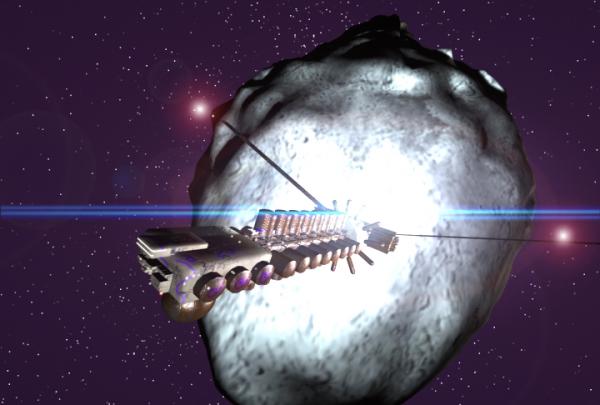BY LETTER
Freelance Prospector
 Image from Juan Ochoa |
Freelance Prospector — Data Panel | |
| Definition | Individualist miners or artifact fossickers away from the developed worlds |
|---|---|
| Sophont Categories | Often standard sapient bionts (usually nearbaselines, tweaks, or bioborgs), sometimes also cyborged. However superturing and first toposophic transapient artificials are in high demand, especially as specialised mining and extraction sentient ships. |
| Clades and Phyla | Prospecting is remarkably common among nearbaselines, whether unmodified or tweaked and/or cyborged, possibly because of the mystique of the rugged individualist making eir living without assistance of the ruling ai. Sophont mining machinery and space vessels often take up prospecting as well. |
| Distribution | Found in more isolated and less developed star systems throughout known space. |
| Est. Numbers | Maybe 50 trillion full time, a larger number part-time (includes all categories). |
| Environmental and Physiological Requirements | Most prospectors have a ship or capsule with all survival needs, although microgravity adaptation or familiarity is mandatory. Some prospectors (especially artificials and some cyborgs) are vacuum capable. |
| Psychological Requirements | Prospectors must have a very high boredom tolerance threshold, be able to cope with long periods (months, years, or decades) of solitude or only minimal company. This is one occupation where being a misanthropist or cranky loner is a plus! |
| Skills | Knowledge of asteroidology and cometology, geology, metallurgy, SCM operation, and small habitat maintenance are generally required. Because the nearest help may be hundreds of millions of kilometers or even light years away, a semperist ability to improvise, jury-rig machinery, and lo tek is essential. |
| Technology | May be High Tech, Ultra Tech, Transapient tech, or a combination of all three, depending on the individual and situation. The most advanced prospectors may have access to specialised magmattertech devices. Usually Drytech, although some highly modified vacuum adapted subsapient or subsentient neogens are used by some clades. |
| Legal Status | Provided one has a permit, freelance prospecting is legal throughout the civilized galaxy and most small polities beyond. |
| Opportunities | Varies. Permits may be easy or difficult to get, depending on the polity. Sephirotics and transapients may also provide openings. The NoCoZo for example offers lucrative franchise opportunities, and there are always mining corporations looking for grunt workers. The Solar Dominion Negentropy Alliance, and Terragen Federation encourage the individual prospector and provide all equipment required. Sometimes a neumann or development swarm will employ or grow as templates prospectors to aid with development of a local star system. |
| Payment | Prospectors who work for mining corporations or transapient development swarm will dock a regular pay (usually in erg- or data-credits or company script). However, any rare artifacts discovered belong to the company or polity. Company prospectors are generally sneered at by the solitaries, who consider themselves the only true prospectors. The solitary or freelance prospector generally makes some income processing metal or volatile rich asteroids, but to get rich (the dream of every solitary) they have to hope that ey will make a lucky strike. Occasionally a prospector will discover an unusual artifact, left by a long-passed or transcended transapient civilization, and even more rarely a xeno artifact and become rich beyond eir wildest dreams. But this happens so infrequently in real life (despite being an eternal staple in virchdrama interactives) as to be little more than fantasy as far as the average prospector is concerned. |
| Hazards | Although most often the biggest dangers are those of the unforgiving environment of space, or an accident with a mining nuke or disassembler nano, danger can come from sentients as well. Some small non-affiliated polities do not look kindly on foreign prospectors, ahuman ai do not recognise sentient rights, and local pirates and predators may murder a prospect for eir equipment. So it is often recommended that prospectors only fossick in sephirotic designated areas. Unfortunately, the type of sophont that becomes a prospector is often the type who does not like to follow rules, and prospectors are notorious for getting into trouble. |
Prospecting has been called the "second oldest profession" in space (the oldest is variously "astronaut" (an Old Earth term) or "scientist"). During the Early Interplanetary period, when advances in tech and manufacturing brought space travel within the reach of everyone, the asteroid prospector was indeed the "everyday hero" who followed their dream and endured great privation and hardship to open up space to humankind. While their job was never glamorous (and often involved long periods of boredom and isolation) they were often romanticised as the people who were opening up the "high frontier", and those few who did strike it rich often became international celebrities. Even failed prospectors could make a comfortable living on the virch-circuit.
The rise of the superturings and their evolution into hyperturings with the first singularity, and their gradual ascension to control and rulership over mindkind changed the governing order, but did not effect the livelihood of the average prospectors, who still plied their trade as they always did. Of far greater danger to their traditional lifestyle were the megacorp monopolies and big mining companies, who were in an easy position to buy out the small operator, and were often vilified in popular virchdramas. More often however the big development corps saw the memetic and pragmatic value of the dowdy and hard-working prospectors, and gave them franchise deals in places where larger operations were not profitable.
During the Technocalypse period the prospectors, long accustomed to extended self-sufficiency in small and isolated environments, were uniquely suited to survive; especially the ice-haulers and comet-miners in the Kuiper belt and beyond. A number formed loose communities, linked by occasional laser and microwave communications link, and some of these - especially the family and clan-orientated prospector communities - evolved into haloists or hiders, many of which were later to join the Federation, others to proceed outwards to the Barnard Belt and along the Beamrider Trade Routes.
The rise of new clades of artificials, and the mammoth interstellar corporations, with resources and projects that dwarfed even the biggest Solsys Era transnationals, meant the marginalisation of the biont or cyborg prospector. Ultratech sentient development probes colonised the universe on amat torches or beamrider sails, developing local resources in each new system in a way the old prospectors could never compete with.
Paradoxically, the eclipse of the nearbaseline prospector only enhanced em in the eyes of the ordinary biont, who saw prospecting as a way to assert their independence free of hyperturing hegemony. Endless virchdramas, often with absurd and facile plotlines, were churned out by the (ironically hyperturing owned and managed) mediacorps, revolving around the lives and adventures of fictional or mythologised real prospectors who make their destiny away from the Federation and, later, the Sephirotic Empires
Most prospectors lived an isolated self-sufficient existence for decades or centuries before returning to civilization for upgrades and rejuvenation, only to set out again for the frontier. While a large number had no greater influence on galactic affairs, a few prospectors and ex-prospectors became incorporated in or gave rise to semperist, hider, and haloist clades and civilizations, or settled down to form wildhu or mainstream polities. This situation still has not changed to this day, although few non-hider ex-prospector clades survive long
The freelance prospector has been an archetypal image in the minds and imagination of terragens for thousands of years, and artificials (both freelance and in the employ of higher toposophics) are essential in the expansion of civilization and the development of new worlds and solar systems. In comparison, most biont and cyborg freelancers achieve very little, even with advanced tech, and it is widely agreed among sociologists and transapientologists that the only reason they are encouraged was as a memetic exercise, to give hu and other basic sophont citizens a feeling of self-esteem and illusory autonomy. This hypothesis of course is something that the biont and cyborg prospectors themselves have neither the patience for or the inclination to believe. For them, life goes on as it always has, and the life in the Second Oldest Profession in Space is one that, for all its hardships, they find deeply satisfying.
Related Articles
- Asteroids and Asteroid Mining
- Astrography
- Geologist - Text by M. Alan Kazlev, from the original by Robert J. Hall
One who studies or practises geology. While most geologists in the long inhabited and colonised regions of space are hobbyists and amateurs, most scientific, colonization, and interstellar surveying expeditions and deep space probe missions include at least one geologist (biont, vec, ai, or turingrade expert system) and usually several when mapping and exploring new solar systems, terraforming likely planets. Geologists are also consulted by prospectors, surveyors or developers when searching for valuable minerals, water, natural gas, or other useful planetary resources, selecting a good site for a habitation dome or mining operation on an unexplored or little known planet, and so on. - Geophysics - Text by M. Alan Kazlev
The study of the structure and dynamic behaviour of terrestrial moons and planets. Includes elements of geology, applied physics, and planetology; study of the geosphere mapping the internal planetary structure; the properties of rock within a planet; planetary formation, development, tectonics and seismology; the nature, history and evolution of the planetary magnetic field if any; and options for terraforming and/or megascale engineering. - Mineral - Text by M. Alan Kazlev
Any naturally-occurring solid of definite chemical composition whose atoms usually form a regular pattern. Artificial or entirely biogenic solids, or amorphous materials like glass, are not considered minerals. Common examples of minerals on the surface of a Gaian type planet are quartz, various feldspars, calcite, or olivine. In the outer reaches of a solar system ice is one of the most abundant minerals on the surface. Rocks may be composed of one or many different kinds of minerals. - Prospecto
Appears in Topics
Development Notes
Text by M. Alan Kazlev
Initially published on 16 June 2010.
Initially published on 16 June 2010.







